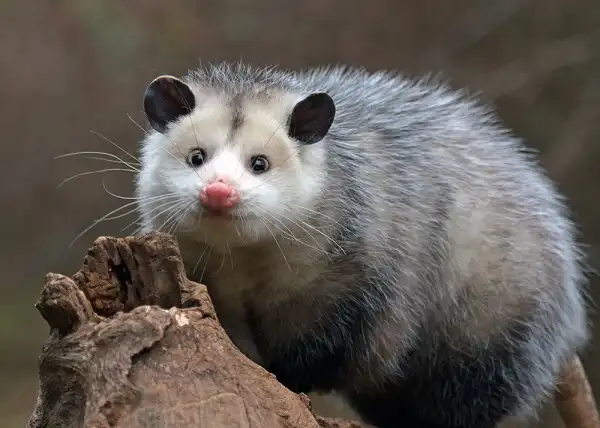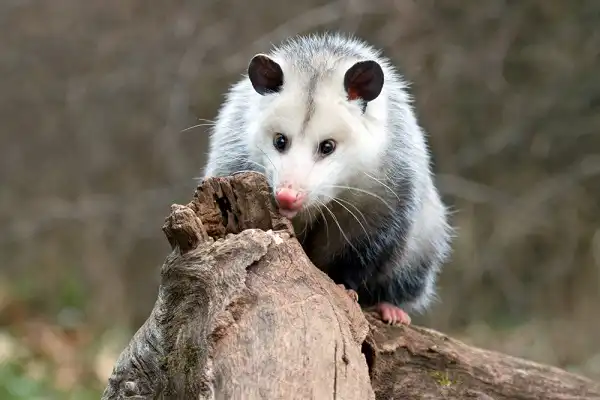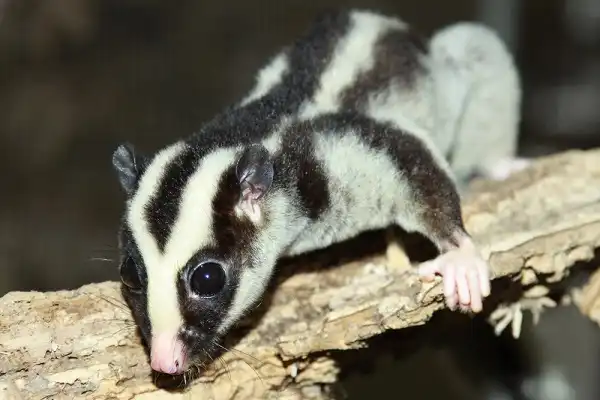Possums are one of the most interesting animals in North America. They are often misunderstood and considered to be pests, but they play an important role in the ecosystem. Join me as I explore the world of possums and learn more about these amazing creatures!

Possum Description
Possums are small, nocturnal marsupials found in North America and parts of Central and South America. They range in size from the diminutive Virginia opossum to the larger Australian brushtail possum. Possums have a coat of coarse fur which is usually grey or brown in color but may be white or black depending on the species. They have long whiskers, thin legs, and a long, thin tail which they use for balance when climbing trees or hopping along the ground. The most distinguishing feature of possums is their distinctive snout which is long and pointed with an upturned nose.
Possum Habitat
Possums are found in a variety of habitats including woodlands, scrublands, wetlands, and urban areas. They prefer dense vegetation which provides them with cover from predators and foraging opportunities for food. In North America possums inhabit deciduous forests, coniferous forests, grasslands, and even some desert regions. In wooded habitats, possums use tree hollows or abandoned burrows as dens. They may also build elaborate nests high up in trees using twigs, leaves, and grasses to create a warm shelter. When living in urban areas they find shelter in attics or wall cavities of buildings. The presence of possums has both positive and negative implications on the environment depending on the species present; some possum species help disperse seeds for new plant growth while others can wreak havoc on native birds by raiding their nests for eggs or baby birds. As opportunistic scavengers possums have been known to raid garbage cans for food scraps leading to problems with homeowners.
Possum Diet
Possums are omnivores and they feed on a wide variety of items including fruits, vegetables, nuts, berries, fungi, insects, bird eggs, small mammals and even carrion. Although much of their diet is made up of plant matter such as fruits and seeds, possums will consume small animals when the opportunity arises. In the wild, possums will forage for food mainly at night when they are less likely to be seen by predators. They will also climb trees in search of food such as fruits or nuts. When living in urban areas possums may feed from garbage cans or other sources of human-provided food scraps. Possums have an especially varied diet depending on the season and availability of food sources in their environment. In springtime, they consume more plant matter such as flowers and leaves while during the summer months, they tend to eat a lot more bugs like beetles and caterpillars. In autumn possums rely heavily on the abundance of fallen ripe fruit and nuts that are available at this time of year. During winter when these sources become scarce they will turn to scavenge carrion or raiding bird nests for eggs or baby birds when needed.

Possum Size
Possums come in a variety of sizes, ranging from the little Pygmy Possum which typically measures only 4 inches in length and weighs around 1.1 ounces to the Common Brushtail Possum which can reach lengths of up to 20 inches and weigh over 5 pounds. There are also some intermediate-sized possums, such as the Golden-mantled Ringtail Possum which reaches 8-11 inches long and usually weighs between 0.7-3.3 ounces. In addition to body mass, other factors such as tail length and hind limb length can be used to measure the overall size of a possum; tails typically measure 6-16 inches while hind limbs reach lengths between 44-150 millimeters (1.7 – 5.9 inches). Through studying the size of different species’ limbs, researchers have been able to gain insights into locomotor strategies used by different populations of possums as well as how they interact with their environments in terms of motion efficiency, habitat selection, etc.
Possum Lifespan
Possums have relatively short lifespans compared to other mammals, typically living between 1-5 years in the wild. Contrary to popular belief, there are some species of possums that can live up to 10 years or more in captivity. One of the oldest recorded possums is a Grey Short-tailed Opossum that was believed to be over 12 years old when it died at the zoo. In addition, factors such as nutrition and reproductive health can also play a role in determining how long a possum lives. Those that have access to adequate amounts of food and water tend to live longer than those who do not because without proper nutrition their bodies cannot function properly and become weak; this then leads them susceptible to disease or injury which could shorten their life span significantly. Overall, while possums generally have relatively short lifespans compared to other mammals, there are certain factors such as species and environment that play important roles in determining how long they will live; these include access/availability of food sources, protection from predators/harsh weather conditions, nutritional status and reproductive health among others.
Possum Behavior
Possums are relatively passive creatures and usually avoid confrontation with other animals. They have a number of defense mechanisms at their disposal if they feel threatened, including playing dead, making loud noises, and spraying a foul-smelling liquid from their anal glands. They will also hiss and growl when cornered or in danger and may bite if provoked. Possums are also quite adept at climbing trees to create higher vantage points so they can more easily observe the area around them before making an escape. Possums tend to be solitary animals but will sometimes live in small groups of up to six individuals. The most common type of possum social behavior is mutual grooming; this helps ensure both parties stay clean and healthy by removing any parasites that could potentially harm them. Possums are also highly territorial and will mark their territory with scent glands found on their feet by rubbing them against objects within the vicinity; these scent markings help deter potential predators or competing possums from entering their space. In terms of communication, possums produce numerous vocalizations such as snarls, grunts, squeaks, clicks, whines, and growls; each has its own specific meaning which can range from a warning call to greetings between family members. Possums have also been known to utilize chemical signals as well; they use pheromones released through certain body parts like the face or tail that play an important role in things like reproduction and attracting mates during courtship rituals.

Possum Speed
Possums are relatively slow-moving creatures, typically traveling no more than one kilometer per night. However, this does not mean that they cannot be agile when necessary. When threatened or startled, possums can move quickly and with great agility to escape from danger. They are able to climb trees in order to reach higher areas for shelter and can also jump short distances when needed. When it comes to running speed, possums can reach speeds of up to 16 km/h (10 mph). This is significantly slower than other animals their size such as rabbits which can reach speeds of up to 35 km/h (22 mph). In comparison, the fastest land animal on Earth—the cheetah—can run at speeds of up to 96 km/h (60 mph). Overall, possums may not be the fastest creature on land but their agility and dexterity make them more than capable of escaping danger when needed. Thanks to their strong passion for swimming, they are able to navigate large bodies of water with relative ease while taking advantage of their prehensile tails whenever possible; these adaptations combined with their knack for finding safe places in trees make them formidable opponents against any potential predators they may face!
Possum Hunting
Possum hunting is a popular outdoor activity that involves tracking, trapping, and hunting possums for their fur, meat and other body parts. It is important to note that there are laws and regulations in place that dictate how possums may be hunted in order to ensure the safety of both humans and animals. In terms of equipment, hunters typically use traps such as box-like cages or leg-hold traps in order to capture the possum. Once caught, the animal can then be killed by either manual strangulation or with a firearm if available. In most instances, manual strangulation is preferred due to its quickness and cleanliness; however, firearms can also be used when necessary or desired. If a firearm is not available then a knife or spear can be used to finish off the animal. There are also a number of commercial baits available on the market which have been specifically designed for trapping possums; these typically contain ingredients like fishmeal, peanut butter, and oats which are known to attract them more efficiently than ordinary food sources. Overall, possum hunting can be an enjoyable hobby with proper preparation and due diligence taken into consideration beforehand. With the right equipment and knowledge of one’s environment coupled with a keen eye for spotting potential traps left behind by others; this exciting activity has long been enjoyed by outdoorsmen everywhere seeking adventure while being mindful of conservation efforts surrounding wildlife management practices!

Conclusion
The possum is an incredibly versatile and adaptive creature that is well-equipped to deal with a wide variety of environments. Its unique prehensile tail helps it navigate tight spaces, climb trees and swim, while its impressive agility makes it capable of evading predators when needed. Possums are also known to be rather shy creatures, but hunters have learned how to track and trap them in order to harvest their fur and meat for various uses. With proper safety precautions taken into consideration as well as familiarity with local regulations regarding hunting; anyone interested can partake in this thrilling activity while being mindful of conservation efforts surrounding wildlife management practices!
Frequently Asked Question


